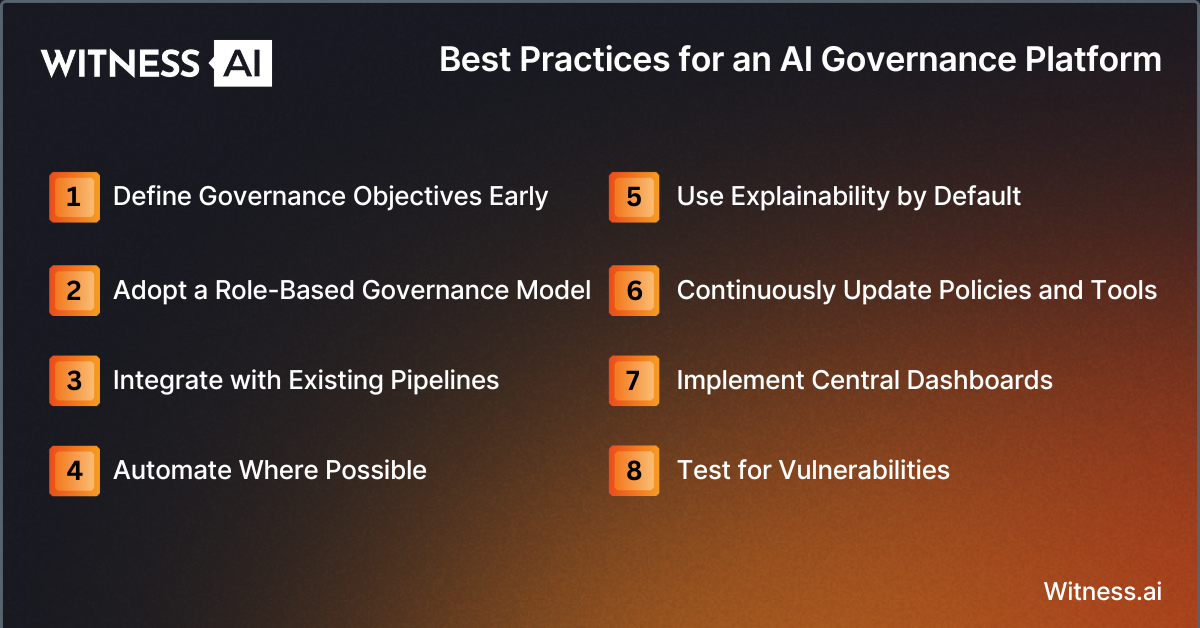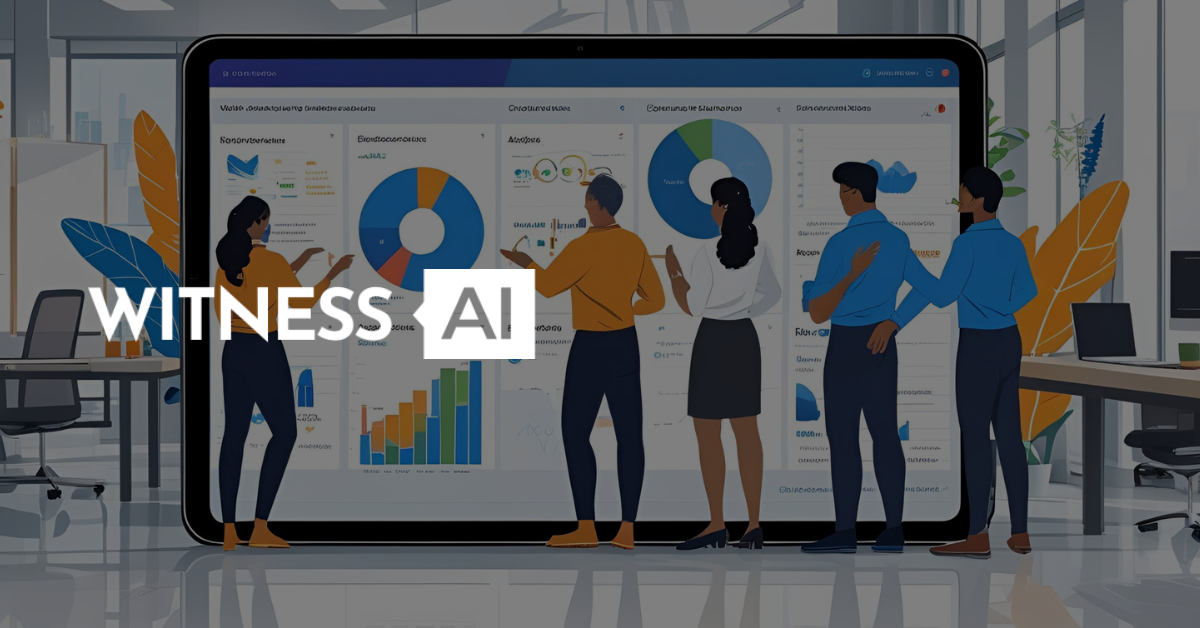What Are AI Governance Platforms?
An AI governance platform is a dedicated software solution that enables organizations to manage, monitor, and ensure the ethical, secure, and compliant use of artificial intelligence (AI) technologies across the full AI lifecycle. These platforms help operationalize AI governance frameworks through automation, policy enforcement, and real-time insights that align with business objectives and regulatory demands.
Key Features and Capabilities
A modern AI governance platform typically includes:
- Model Registry and Lifecycle Management: Track and document all AI models and their versions from development through deployment and retirement.
- Risk Assessment and Mitigation Tools: Identify and score AI risks based on regulatory, ethical, and technical criteria.
- Automated Workflows: Standardize approvals, reviews, and remediation steps across AI use cases and workflows.
- Explainability and Transparency: Offer model interpretability, lineage, and decision-making logic to meet internal and external requirements.
- Regulatory Compliance Dashboards: Provide visualizations and metrics for adherence to AI regulations like the EU AI Act, NIST AI RMF, and sector-specific laws.
- Data Governance Integrations: Monitor data quality, lineage, and data privacy risks within training and inference pipelines.
- Stakeholder Collaboration Tools: Coordinate across data scientists, legal teams, compliance officers, and business units.
- Audit Logging and Reporting: Maintain immutable records of AI activities, decisions, and changes to support audits and investigations.
Platforms like Credo AI, Microsoft Responsible AI tools, and other AI governance solutions support the implementation of these capabilities within scalable enterprise environments.
What Is AI Governance?
AI governance refers to the processes, structures, and policies that guide the use of AI in an organization to ensure it is ethical, lawful, and aligned with organizational values and stakeholder expectations. It encompasses AI risk management, oversight, and accountability across the entire AI lifecycle.
Effective AI governance addresses:
- Ethical AI considerations: fairness, accountability, transparency
- Technical risk: robustness, model performance, data quality
- Legal compliance: alignment with AI regulations and privacy laws
- Organizational alignment: adherence to company values and strategies
Without governance, AI systems may expose organizations to legal liabilities, biased outcomes, or reputational harm. Governance platforms make this oversight scalable, auditable, and embedded in operational practice.
What Are the Benefits of an AI Governance Platform?
Organizations adopting generative AI, machine learning, or other advanced AI technologies face growing scrutiny. A dedicated governance platform ensures that AI initiatives align with ethical, legal, and strategic goals.
Key Benefits:
- Regulatory Compliance: Meet evolving global requirements, including the EU AI Act, U.S. AI Executive Orders, and industry-specific standards.
- Risk Management: Detect and mitigate issues such as bias, security vulnerabilities, and model drift before they lead to harm or reputational damage.
- Operational Efficiency: Streamline governance through automation and centralization, reducing manual work and inconsistencies.
- Stakeholder Trust: Build confidence among internal stakeholders, customers, and regulators with verifiable responsible AI practices.
- End-to-End Oversight: Gain visibility into every phase of the AI lifecycle, from data acquisition to real-world model performance monitoring.
- Scalable Control: Implement consistent guardrails across hundreds or thousands of models, teams, and AI projects.
These benefits enable businesses to scale AI adoption responsibly while minimizing disruption and avoiding costly missteps.

What Are the Best Practices for an AI Governance Platform?
To unlock the full value of an AI governance platform, organizations should adhere to several best practices:
1. Define Governance Objectives Early
Align governance initiatives with business strategy and regulatory landscapes. Establish priorities for ethical AI, compliance, risk mitigation, and innovation enablement.
2. Adopt a Role-Based Governance Model
Define responsibilities across stakeholders—e.g., data scientists manage model governance, while legal teams oversee regulatory compliance and ethics.
3. Integrate with Existing Pipelines
Embed governance checks into MLOps, data pipelines, and software development lifecycles. Real-time validation improves responsiveness and reduces rework.
4. Automate Where Possible
Leverage automation to apply policies, monitor data sets, and detect drift or anomalies. This enhances consistency and scalability across AI deployments.
5. Use Explainability by Default
Ensure models meet explainability thresholds required for risk-based use cases, particularly in regulated industries like finance, healthcare, and insurance.
6. Continuously Update Policies and Tools
AI evolves rapidly. Periodically revise your AI policy, tools, and workflows to remain aligned with regulatory requirements and technological developments.
7. Implement Central Dashboards
Maintain real-time dashboards that aggregate governance status, model risk, and performance indicators. This supports proactive decision-making and transparency.
8. Test for Vulnerabilities
Regularly audit models for security vulnerabilities, data privacy gaps, and unintentional bias. Adopt a red-teaming mindset when stress-testing your systems.
Who Oversees an AI Governance Platform?
Oversight typically involves a cross-functional team combining:
- Chief AI Officer / Head of AI Governance: Owns the strategy and vision for governing AI.
- Legal and Compliance Teams: Ensure alignment with regulatory compliance mandates like the EU AI Act and privacy laws.
- Data Scientists and ML Engineers: Implement model governance, validation protocols, and technical assessments.
- Cybersecurity Teams: Monitor AI-related cybersecurity threats and integrate secure development practices.
- IT and DevOps: Manage system integrations, access controls, and platform scalability.
- Ethics Officers / Responsible AI Committees: Advocate for AI ethics, societal impact, and human oversight.
In mature organizations, AI governance is part of broader risk management or data governance programs and may align closely with ESG (environmental, social, governance) strategies.
Why Do Businesses Need AI Governance Platforms?
As AI use cases become more embedded in core operations—from decision-making algorithms to generative AI content tools—so too do the risks. Governance platforms help businesses:
- Navigate Complex Regulatory Landscapes: The EU AI Act, sector-specific U.S. guidance, and emerging global norms make manual governance untenable.
- Support Responsible Innovation: Accelerate safe experimentation by embedding guardrails early in the development lifecycle.
- Preserve Brand Trust: Avoid ethical scandals and non-compliance penalties through transparent, verifiable governance of AI.
- Enhance Data Protection: Monitor for inappropriate use of AI on sensitive data and ensure robust data protection and access controls.
- Optimize Model Deployment: Use real-time signals and performance data to prioritize safe and effective AI development.
- Enable Continuous Oversight: Platforms provide an always-on view into how AI systems are functioning and whether they are adhering to defined AI governance practices.
These platforms help organizations go beyond static checklists and embrace dynamic, scalable AI compliance solutions.
How Do AI Governance Platforms Ensure Compliance with Regulations?
Compliance requires more than documentation—it demands demonstrable alignment with legal, ethical, and operational expectations. AI governance platforms support this by:
- Mapping Use Cases to Risk Categories: Classify AI systems per frameworks like the EU AI Act (e.g., minimal, limited, high, or unacceptable risk).
- Automating Documentation and Audits: Maintain real-time records of policies, risk assessments, and mitigation steps.
- Embedding Regulatory Criteria: Platforms encode regional laws and global standards into templates and checklists.
- Conducting Risk Assessments: Evaluate AI models for fairness, bias, robustness, and explainability before release.
- Tracking Model Drift and Retraining: Ensure ongoing model performance remains within safe bounds after deployment.
- Flagging Noncompliance Early: Dashboards provide visibility into emerging compliance risks and unresolved policy violations.
With growing legal scrutiny and rising expectations for responsible AI, platforms offer a scalable way to stay ahead of changing regulatory requirements while minimizing human error and resource strain.
Conclusion
In today’s AI-driven world, governance is not optional—it’s foundational. AI governance platforms provide the structured, automated, and scalable infrastructure organizations need to manage the growing complexity and risk of AI systems. By integrating ethical principles, legal compliance, and operational discipline, these platforms help organizations innovate responsibly, protect stakeholders, and maintain trust in their AI technologies.
As regulatory scrutiny intensifies and AI adoption expands, businesses that invest in robust governance platforms are better positioned to lead in both compliance and performance.
About WitnessAI
WitnessAI enables safe and effective adoption of enterprise AI, through security and governance guardrails for public and private LLMs. The WitnessAI Secure AI Enablement Platform provides visibility of employee AI use, control of that use via AI-oriented policy, and protection of that use via data and topic security. Learn more at witness.ai.
